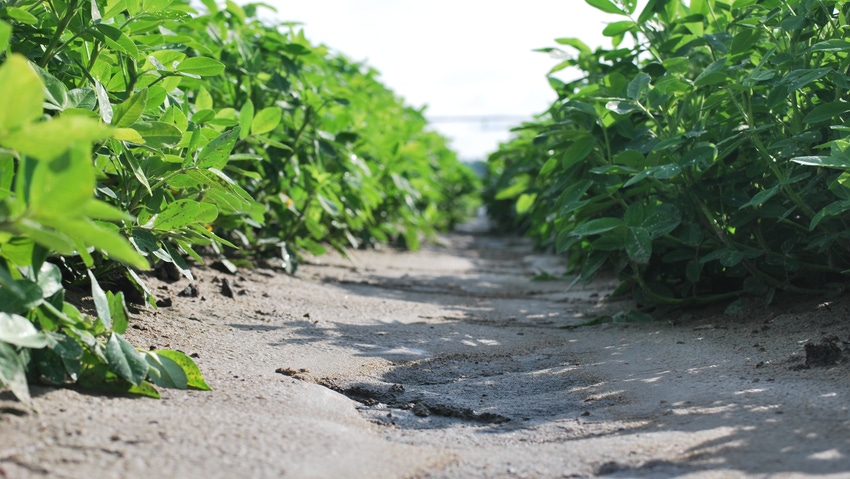
At a Glance
- The peanut burrower is a native, underground stink bug.
- The goal is to develop tools for control so IPM or integrated pest management practices can be used.
Back in 2010, Mark Abney was happy in his job as a vegetable entomologist at North Carolina State University. But then the peanut burrower bug became a problem in his home state of Georgia, and the University of Georgia beckoned.
“There was a lot of burrower bug injury in the state of Georgia in 2010. At that time, I was a vegetable entomologist at North Carolina State University, and very happy. There was no peanut entomologist in 2010 at the University of Georgia. One of them became a dean, and one of them retired, and there was nobody,” Abney said in a talk at the annual meeting of the American Peanut Research and Education Society (APRES) at the DeSoto Hotel in Savannah July 13.
“They called me and said ‘do you want to become our peanut entomologist. I said, I’m from Georgia, I’d love to do that. This insect is why I’m here today. Otherwise, I’d be at a sweetpotato meeting.”
So, in 2013, Abney and his family moved to Tifton to begin work on the burrower bug and other insect challenges as the new Extension peanut entomologist at the University of Georgia. For 10 years, he’s been seeking answers and solutions to the peanut burrower problem and other insect issues in Georgia peanuts.
It’s a challenge, because so much is unknown about the peanut burrower bug. And because it is a sporadic pest that doesn’t show up every year and, in every field, it hasn’t been widely studied over the years.
The well-known and respected Clemson Extension Peanut Specialist Jay Chapin studied the burrower bug when it was a problem in South Carolina in the 1990s, and it has also been studied in Texas where burrower bugs have been an issue since the 1970s.
“We didn’t know its host range. We didn’t know its reproductive biology. How many eggs does it lay? Where does it lay its eggs? Where is it? What is its habitat? Where is it distributed within Georgia and the Southeast? How does it move? How does it get into a peanut field? How does it move in the environment? These are things we did not know,” Abney said at the APES gathering.
Abney defines the peanut burrower as a stink bug that lives in the ground. It’s native to the U.S. and was not a problem in peanuts until now. “The insect is from here. It wasn’t introduced here; it wasn’t brought here. It’s been in Georgia forever essentially, and not a problem until relatively recently.”
The burrower bug is a piercing, sucking insect. It’s called a burrower bug because it burrows in the soil, not because it burrows in the peanut. “It sticks that piercing, sucking mouth part through the pod wall underground, and sucks the juice out of the seed, and it leaves these discolored yellow pits on the seed. We’re not expecting yield loss from this insect. It’s a quality issue,” Abney said.
The peanut burrower bug presents quality challenges to peanuts because it severely reduces the grade of peanuts for consumption. Every peanut buying point in the state is staffed by inspectors from the Georgia Federal-State Inspection service, an independent third-party inspection agency that inspects more than 35 commodities in the state, including peanuts.
As Abney explains, every peanut load in the United States goes through this third-party inspection. If a peanut lot has more than 3.49% injury by weight, those peanuts get downgraded from a Segregation 1 rating to a Segregation 2 rating. Segregation 2 peanuts can’t be made into peanut butter and are crushed for oil.
“It decreases the value of those peanuts from let’s say $500 a ton down to about $120 a ton, and guess what, you go out of business if you grow peanuts at a $120 a ton,” Abney said.
“We don’t know diddlysquat about this insect’s basic biology. We don’t have a way of monitoring it. We don’t have thresholds. We didn’t know what risk factors were associated with this insect being present in the field. What is causing this insect to be where it is from one year to the next. We can’t predict where damage is going to occur.”
Abney said the goal is to develop tools for control so IPM or integrated pest management practices can be used to control the peanut burrower bug. The challenge is there is no effective chemistry to control the peanut burrower bug since use of the one effective compound, chlorpyrifos, has been banned by the Environmental Protection Agency.
“We’re looking to expand management beyond chemistry,” Abney said.
Abney said one key is burrower bugs don’t like tillage. Tillage makes a difference. Deep tillage reduces injury.
Abney believes the variety Georgia 06-G might be the most susceptible variety to the peanut burrower bug. Georgia 06-G was released in 2006 and soon became grown on a large amount of acreage across Georgia; four years later, in 2010, the peanut burrower bug became a problem.
“Is it a coincidence? I think maybe not. Maybe Georgia 06-G is more susceptible than the other cultivars,” he said.
Abney noted that large fields have less injury than smaller fields, probably because only certain parts of large fields are suitable for burrower bugs to live. He said rainfall makes a difference. When it’s dry, burrower bug pressure increases.
“We know a lot more about burrower bugs than we did 10 years ago. We still can’t manage them. And that’s the real problem. If we don’t get effective chemistry, in my opinion, we’re not going to have a good answer for this insect,” he said.
“Peanut growers in Georgia remain at risk to losses from burrower bugs. That has not changed. It’s not going to change anytime soon.”
About the Author(s)
You May Also Like






